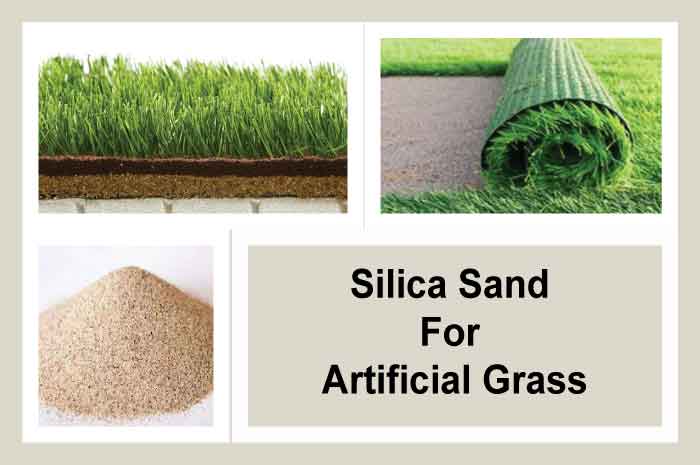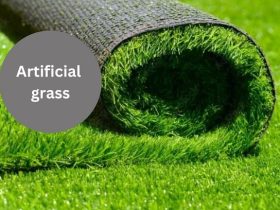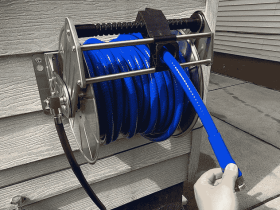Do you know anything about silica sand? What is the connection between silica sand and artificial grass? If you are curious about it, I will explain it to you. Silica sand is a sand made from silicon dioxide (SiO2). Other names for this sand are quartz or industrial sand, a highly durable mineral that withstands heat and chemicals. Mostly this material is widely applicable for industrial and social use. Depending on the grain size, refractories, texture, and shape, silica sand is used for multiple things. One of its uses is to filter out dirt or mud that sticks to the surface.
So, what is the relationship between silica sand and artificial grass? Silica sand is one of the infills you need when using artificial grass for your yard. This sand consists of grains of sand with the right weight to maintain the sturdiness of grass. In this article, I will explain its benefits and downsides as an artificial grass infill.
Benefits of using silica sand for artificial grass
As I said before, silica sand is used for artificial grass to maintain its sturdiness. Not just that, but there are many reasons or benefits why you need silica sand for your artificial grass.
1. Structural component for artificial turf
Silica sand can improve drainage and become a solid structural base for turf. As a structural component, silica sand helps the blades of artificial grass to stand upright. It is a foundation for artificial grass, so it would not budge around much. It is firmly attached to the ground and forces the grass blades to stay straight and firm because it sets on all spaces between blades.
2. Durable and affordable price
Silica sand is the most common infill for turf because of its price. It is inexpensive compared to other infills. Even though the price is affordable, this material is durable for your turf. It protects the grass fibres and prevents the turf from tearing up because it acts as a protective layer.
3. Thermal insulation
Installing artificial grass outside will inevitably be exposed to direct sunlight. Therefore, you need to choose a heat-resistant grass material. The application of silica sand can also help lower the surrounding temperature.
4. Give natural vibes
Due to the firmness of silica sand, artificial grass can feel like genuine grass. The non-angular silica sand has a smooth surface. It is comfortable to walk on artificial grass because it fills the ground. It makes your artificial grass look more natural.
Downsides of using silica sand for artificial grass
After I tell you the reasons or benefits of using silica sand, I will also tell you the downsides of this sand. Of course, this can be your consideration to have silica sand as infill.
1. Cover low-foot traffic
Silica sand is an abrasive material. It can erode and release harmful dust from the material. The sand can become worn out if there is a lot of activity above it.
2. Clogging the drainage
Because it consists of angular-shaped sand, this infill has a high chance become hardening and clumping together. It can happen if the sand is exposed to water frequently, especially in places where it rains a lot. It also can clog the drainage below artificial grass.
3. Traps odour
Silica sand can trap pet odour inside. It can be terrible for your artificial grass. You will have to clean the turf frequently to remove odours.
What grade of silica sand is for artificial grass?
Silica sand grade 20 is the common one for landscape artificial grass lawns. It has a natural and pure look. This grade is also of high quality and has a high water-absorbing capacity. Silica sand grade 30 is also ideal for sand-filled artificial grass because it has smaller granules.
How much silica sand do I put on artificial grass?
The amount of silica sand applied to the artificial turf surface will depend on the usage and brand of silica sand purchased. Silica sand in the golf course will be used more than in the residential landscape artificial grass per meter square. It is common to use 4-5 kg for one square metre.
What can I use instead of silica sand for artificial grass?
Due to silica sand shortcomings, here are some alternative fillers for artificial turf:
1. Crumb rubber infill
Crumb rubber gives a natural grass feel. However, this infill uses for sports fields or other high-foot traffic areas rather than residential landscapes. Rubber infill adds volume, makes the turf look lush and keeps blades upright. This material provides shock absorption, so it is safe for athletes. It also has downsides. It can trap odour and does not kill any bacteria. Not only that, but it can also leave black dust on clothing, shoes, or other things. Rubber also can absorb heat from sunlight and make the yard hot.
2. Zeolite Infill – Zeofill
This material is a popular one among pet lovers. As a natural organic product, it absorbs urine and prevents odours by capturing ammonia gas. Zeofill will suppress and hold the ammonia gas until it is washed away during cleaning using water or rain.
3. Antimicrobial Sand – Envirofill
Just like it claims, Envirofill is antimicrobial protection sand. This coated sand is a popular type of infill among homeowners. Envirofill has rounded granules and provides more absorbency. It is ideal for pet turf installation because It does not absorb liquids. It can kill bacteria and is safe for children to play on the turf. This sand is green-coloured and easy to blend with artificial grass. Unfortunately, this Envirofill is quite pricey compared to silica sand and crumb rubber.
4. Cork infill
This natural infill consists of granulated cork. This material is also commonly used in sports fields. This cork filler has the same benefits as crumb rubber. It can quickly return to its original shape upon impact. However, this infill material is hard to find in small projects. You may need to purchase it for large projects such as golf courses or other commercial fields.
5. Cooling sand Infill – HydroChill
Cooling sand infill, HydroChill is a premium infill for artificial grass. HydroChill can keep your artificial grass cool. It holds moisture from rain or water. After that, it releases moisture through an evaporative cooling system that is stored in sands when the turf gets heated by the sun. It is also non-toxic and has no adverse effects on the environment. They can be more expensive than other effective filling materials.
How do you apply silica sand to artificial grass?
Applying silica sand may take time if you are a first-timer. If you want to save money, you can do it yourself rather than hire a professional. Silica sand as an infill is the final step of artificial grass installation. You need to keep the grass dry to fill it with silica sand. Calculate first how much silica sand you need for your yard. After that, you can divide areas in your yard into pieces to ease the spreading of silica sand. Use a lawn fertiliser spread, a blower, and a stiff brush to apply the sand. Brush the pile before, during, and after sand spreading. If your yard is too large, you can use the electric brush to save time. Remember the purpose of using infill so that the artificial grass can stand upright. When you still see silica sand on top of the grass, keep brushing the area to make the infill goes into the turf.
How much silica sand is for artificial grass?
Most stores sell silica sand in 5kg to 25kg sacks. All prices depend on the brand and where you buy it from. In some places, they sell it for about $13.5 to $24.5 per 5kg. The price does not include shipping costs. Some online stores also offer lower prices with a minimum purchase per tonne.
Where to buy silica sand for artificial grass?
If you want to buy silica sand, you can search for it online. Choose the silica sand grade and look for it in an online shop. Many various brands sell silica sand. Remember to only buy from credible sellers. You can also buy it directly from your local stores. Stores that have expertise in artificial grass usually also sell silica sand.
Conclusion
Installing artificial grass means you also need to buy infill sand. Silica sand is a commonly used infill sand for turf. Silica sand for artificial grass gives many benefits. This sand acts as a support structure for the artificial turf. Silica sand is inexpensive compared to other fillers. It is durable and can function as thermal insulation. Of course, silica sand also has disadvantages. You can replace the infill according to the use of artificial turf in your home. Don’t forget to measure your yard before buying the sand infill to know how much you need it.











Leave a Review